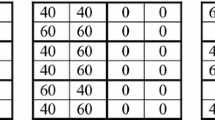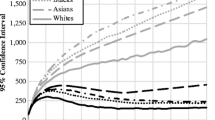Abstract
Residential segregation is a multidimensional phenomenon that encompasses several conceptually distinct aspects of geographical separation between populations. While various indices have been developed as a response to different definitions of segregation, the reliance on such single-figure indices could oversimplify the complex, multidimensional phenomena. In this regard, this paper suggests an alternative graph-based approach that provides more detailed information than simple indices: The concentration profile graphically conveys information about how evenly a population group is distributed over the study region, and the spatial proximity profile depicts the degree of clustering across different threshold levels. These graphs can also be summarized into single numbers for comparative purposes, but the interpretation can be more accurate by inspecting the additional information. To demonstrate the use of these methods, the residential patterns of three major ethnic groups in Auckland, namely Māori, Pacific peoples, and Asians, are examined using the 2006 census data.
















Similar content being viewed by others
Notes
In the segregation literature, the Lorenz curve is often constructed by plotting the cumulative proportion of one population group against that of the other group. The concentration profile is different from the Lorenz curve in the sense that it plots the cumulative proportion of the population group against their relative demographic share in geographic units.
In the 2006 census, Samoan was the largest population group in this broad ethnic category (49.3 %), followed by Cook Islands Māori (21.8 %), Tongan (19.0 %), Niuean (8.4 %), Fijian (3.7 %), Tokelauan (2.5 %), and Tuvaluan (1.0 %). Although each of these groups has distinct cultural, linguistic, and historical backgrounds, we analyze the “Pacific peoples” data as a whole to demonstrate the use of the proposed approach. Note that the census respondents were able to choose more than one ethnic group to describe their ethnicity. The sum of the individual proportions in this data set therefore exceeds 100 %.
While it may be beyond the scope of this paper to explain why Pacific peoples (and the Māori population) are clustered in the southern Auckland, previous studies suggest that the presence of state housing in this locality has attracted low-income Pacific peoples (Johnston et al. 2008).
References
Allen R, Burgess S, Windmeijer F (2009) More reliable inference for segregation indices. CMPO Working Paper Series, vol 216. University of Bristol, Centre for Market and Public Organisation, Bristol
Dorfman R (1979) A formula for the Gini coefficient. Rev Econ Stat 61(1):146–149
Duncan OD, Duncan B (1955) A methodological analysis of segregation indexes. Am Sociol Rev 20(2):210–217
Falk RF, Cortese CF, Cohen J (1978) Utilizing standardized indices of residential segregation: comment on Winship. Soc Forces 57(2):713–716. doi:10.2307/2577693
Friesen W, Murphy L, Kearns R (2005) Spiced-up Sandringham: Indian transnationalism and new suburban spaces in Auckland, New Zealand. J Ethn Migr Stud 31(2):385–401
Grbic D, Ishizawa H, Crothers C (2010) Ethnic residential segregation in New Zealand, 1991–2006. Soc Sci Res 39(1):25–38
Hong S-Y, Yoon H-K (2013) Ethno-economic satellite: the case of Korean residential clusters in Auckland. Popul Space Place. doi:10.1002/psp.1764
Hutchens RM (1991) Segregation curves, Lorenz curves, and inequality in the distribution of people across occupations. Math Soc Sci 21(1):31–51. doi:10.1016/0165-4896(91)90038-S
Johnston R, Poulsen M, Forrest J (2005) Ethnic residential segregation across an urban system: the Maori in New Zealand, 1991–2001. Prof Geogr 57(1):115–129. doi:10.1111/j.0033-0124.2005.00464.x
Johnston R, Poulsen M, Forrest J (2008) Asians, Pacific Islanders, and ethnoburbs in Auckland, New Zealand. Geogr Rev 98(2):214(228)
Johnston R, Poulsen M, Forrest J (2010) Moving on from indices, refocusing on mix: on measuring and understanding ethnic patterns of residential segregation. J Ethn Migr Stud 36(4):697–706. doi:10.1080/13691830903505045
Johnston R, Poulsen M, Forrest J (2011) Evaluating changing residential segregation in Auckland, New Zealand, using spatial statistics. Tijdschr Econ Soc Geogr 102(1):1–23. doi:10.1111/j.1467-9663.2009.00577.x
Massey DS, Denton NA (1988) The dimensions of residential segregation. Soc Forces 67(2):281–315
Morgan BS (1983) An alternate approach to the development of a distance-based measure of racial segregation. Am J Sociol 88(6):1237–1249
Morrill RL (1991) On the measure of geographic segregation. Geogr Res Forum 11:25–36
Openshaw S (1984) The modifiable areal unit problem. Geo, Norwich
O’Sullivan D, Wong DWS (2007) A surface-based approach to measuring spatial segregation. Geogr Anal 39(2):147(122)
Poulsen M, Johnston R, Forrest J (2002) Plural cities and ethnic enclaves: introducing a measurement procedure for comparative study. Int J Urban Reg Res 26(2):229–243
Reardon SF, O’Sullivan D (2004) Measures of spatial segregation. Sociol Methodol 34(1):121–162
Reardon S, Matthews S, O’Sullivan D, Lee B, Firebaugh G, Farrell C, Bischoff K (2008) The geographic scale of Metropolitan racial segregation. Demography 45(3):489–514. doi:10.1353/dem.0.0019
Reardon SF, Farrell CR, Matthews SA, O’Sullivan D, Bischoff K, Firebaugh G (2009) Race and space in the 1990s: changes in the geographic scale of racial residential segregation, 1990–2000. Soc Sci Res 38(1):55–70
White MJ (1983) The measurement of spatial segregation. Am J Sociol 88(5):1008–1018
Winship C (1977) A revaluation of indexes of residential segregation. Soc Forces 55(4):1058–1066. doi:10.2307/2577572
Wong DWS (1993) Spatial indices of segregation. Urban Stud 30(3):559–572
Wong DWS (1997) Spatial dependency of segregation indices. Can Geogr 41(2):128–136
Wong DWS, Reibel M, Dawkins C (2007) Introduction—segregation and neighborhood change: where are we after more than a half-century of formal analysis. Urban Geogr 28(4):305–311
Wright R, Holloway S, Ellis M (2011) Reconsidering both diversity and segregation: a reply to Poulsen, Johnston and Forrest, and to Peach. J Ethn Migr Stud 37(1):167–176. doi:10.1080/1369183x.2011.523865
Xue J, Friesen W, O’Sullivan D (2012) Diversity in Chinese Auckland: hypothesising multiple ethnoburbs. Popul Space Place 18:579–595. doi:10.1002/psp.688
Acknowledgments
This work was supported by JSPS KAKENHI Grant Number 24-02309. We are thankful to the anonymous referees for their constructive comments.
Author information
Authors and Affiliations
Corresponding author
Rights and permissions
About this article
Cite this article
Hong, SY., Sadahiro, Y. Measuring geographic segregation: a graph-based approach. J Geogr Syst 16, 211–231 (2014). https://doi.org/10.1007/s10109-013-0190-7
Received:
Accepted:
Published:
Issue Date:
DOI: https://doi.org/10.1007/s10109-013-0190-7
Keywords
- Segregation measures
- Residential segregation
- Segregation profiles
- Concentration profile
- Spatial proximity profile




